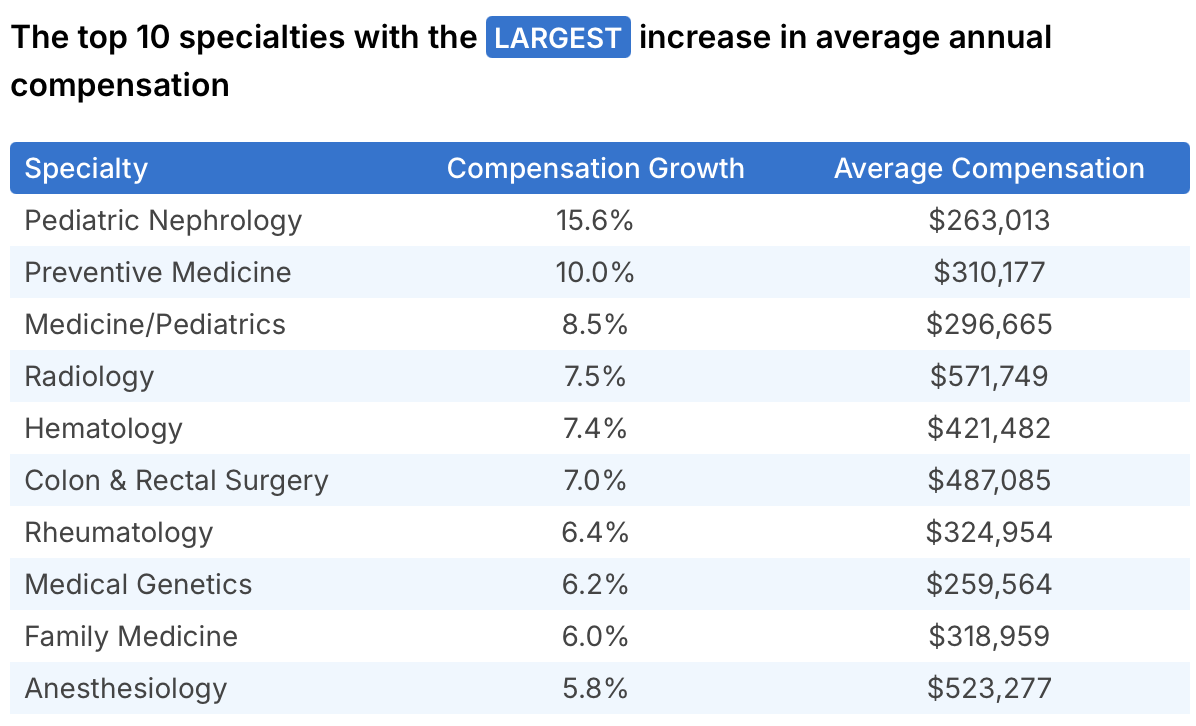Radiology still pays well, and every resident at a career fair ends up asking the same thing: What is the salary of a radiologist right now? The new Doximity Physician Compensation Report 2025 answers that question with hard numbers. This article checks those numbers against outside news reports [1] [2] [3], explains why they moved, and shows how you can use the data when you plan a career, recruit talent, or renegotiate a contract.
The salary of a radiologist
Doximity polled more than 37,000 full-time U.S. physicians. It found that the average salary of a radiologist hit $571,749 for work-year 2024, a 7.5% jump in twelve months. All other doctors, taken together, saw pay rise only 3.7%. In plain words, radiologists earned almost double the average raise [1].

Why did the salary of a radiologist rise so sharply?
Several forces work together.
- Demand–supply gap. Imaging volume keeps climbing with an aging population, yet residency slots and fellowship seats grow slowly. Result: more jobs than radiologists.(2)
- Locum tenens spill-over. Radiology stands No. 6 among the most requested specialties for temporary (locum) coverage. Those premium hourly rates lift permanent offers because employers must compete with locum pay.(1) (2)
- Around-the-clock service. Hospitals need reads 24/7. Night, weekend, and holiday shifts carry cash stipends, raising the blended annual number.
- Fourth-highest growth slot. Within Doximity’s top-ten list of fastest-growing specialties, radiology lands at the fourth spot, behind only pediatric nephrology, preventive medicine, and medicine/pediatrics.(2)
How the salary of a radiologist compares with other fields
Radiology now sits just outside the surgical elite, trailing interventional radiology by a hair, yet outranking many surgical disciplines. Primary-care pay still lags far behind. The report shows surgeons earning 87% more than family doctors; radiology’s own pay growth was almost twice that of family medicine last year [1].
Regional twists that shape real income
Doximity’s metro tables cover all specialties, yet they tell radiologists something vital: money stretches further in smaller Midwestern and Southern markets.
- Rochester, MN tops the pay-after-cost-of-living list again.
- Boston, Seattle, San Francisco, and Washington DC sit at the bottom once rent and taxes are counted.
Thus, a $525k offer in St Louis may leave more spendable income than a $600k offer in San Jose. Always plug numbers into a cost-of-living calculator before signing.

Practice setting and the salary of a radiologist
Across specialties, single-specialty groups average the highest pay at $476,807, followed by multispecialty groups and solo practice. Hospital employment lands in the middle; academic medicine pays the least. Radiology tracks this ladder:
- Independent groups often share profits and sell shares to partners.
- Hospital jobs may trade money for stability or less call.
- Universities provide teaching time and research funds but lower salaries.
Knowing the trade-offs helps candidates judge an offer beyond the headline dollar amount.
Inside the paycheck: productivity and bonuses
Most contracts mix five parts:
- Base salary. Example: $350k.
- Productivity pay. Many groups pay about $250 per work Relative Value Unit (wRVU) after a floor—often 9,000 wRVUs—is reached.
- Shift differentials. A night read can add $1,000 or more per shift.
- Quality or peer-review bonuses. Small, but they add up.
- Equity. Shares in imaging centers or management firms pay dividends and grow in value.
Read the fine print. Two radiologists with identical bases can finish the year far apart if one meets every threshold and the other misses.
Gender-based gaps remain a concern
The report shows a 26% gender pay gap across medicine, up from 23% last year. Doximity did not publish a radiology-specific figure in 2025, but past studies place the specialty gap near 20%. Simple steps, transparent pay bands, equal call pools, and annual audits, can shrink the difference and improve retention.
Cost-of-living math you should not ignore
A dollar earned in Omaha is not worth the same in Oakland. Using U.S. Bureau of Economic Analysis data, Doximity adjusts pay by regional price parities. Even after that correction, Rochester MN remains No. 1, while Boston slides to the bottom tier [1].
If two offers differ by $40 000 but one city’s rent is $1 000 cheaper each month, the “lower” offer can leave you richer. Always test each number in a personal budget.
Will the salary of a radiologist keep rising?
Forecasting pay is never perfect, yet three signals stand out.
- Demand stays high. Chronic disease and population aging push scan counts up year after year.
- AI augments, not replaces. Decision-support tools speed workflow yet create more findings that need human review.
- Policy risk persists. Medicare cut the physician fee schedule 2.8% for 2025; further cuts could slow broad raises, though shift premiums should hold.
Most analysts expect 3–4% growth for 2025-26, with bigger jumps for interventional work or continuous night cover.
Practical tips for maximizing the salary of a radiologist
- Benchmark correctly. Start at $571,749, then adjust for city, call load, and subspecialty.
- Negotiate beyond salary. Sign-on bonuses, loan repayment, and CME funds often move more easily than base pay.
- Watch the workload. Ask how many studies per day and what mix of CT, MR, and X-ray. High volume without matching pay erodes hourly earnings.
- Plan for partnership. If the group sells shares after three years, learn the buy-in cost and the historical dividend.
- Insist on clarity. Make wRVU thresholds and night stipends explicit in the contract.
- Keep skills current. Extra certification in cardiac CT or prostate MRI can unlock additional stipends and keep your profile attractive in a fast-moving market.
Key takeaways
The salary of a radiologist averaged $571,749 last year and grew 7.5%. Demand is strong, supply is tight, and extra pay for night or subspecialty work sweetens offers. Location, practice type, and contract details can swing real income widely, so read every clause and compare offers side by side.
References
- Doximity. Physician Compensation Report 2025. https://www.doximity.com/reports/physician-compensation-report/2025
- Allegretto A. “Radiology makes top 5 specialties for compensation growth.” AuntMinnie (Jul 31 2025). https://www.auntminnie.com/industry-news/market-analysis/article/15751929/doximity-radiology-makes-top-5-specialties-for-compensation-growth
- Stempniak M. “Medicare issues final 2025 physician fee schedule with 2.83 % conversion-factor cut.” Radiology Business (Nov 1 2024). https://radiologybusiness.com/topics/healthcare-management/healthcare-policy/medicare-issues-final-2025-physician-fee-schedule-283-conversion-factor-cut
FAQs
What is the average salary for a diagnostic radiologist in the United States?
The Doximity Physician Compensation Report 2025 shows that a full time diagnostic radiologist earned an average of $571,749 for work year 2024. This amount is 7.5% higher than the prior year, almost twice the 3.7% increase recorded for all other physician specialties.
How much more do interventional radiologists earn than diagnostic radiologists?
Interventional radiologists, who perform image-guided procedures such as angioplasty and embolisation, earn about 2% to 4%more than diagnostic colleagues. The extra pay reflects procedural revenue and round-the-clock intervention call. Demand for general imaging has grown, so the gap is narrower than it was five years ago.
Why did radiologist compensation rise sharply in 2025?
Four forces pushed pay upward. An aging population raised imaging volume faster than residency positions grew, so demand exceeded supply. High locum tenens hourly rates pressured employers to match those numbers. Hospitals added stipends for night, weekend, and holiday reads. Radiology ranked fourth among the fastest growing specialties, so recruiters competed harder for limited talent.
Which US cities offer radiologists the highest cost-adjusted salaries in 2025?
After local prices are applied, mid-sized Midwest and Southern markets lead. Rochester Minnesota is number one for spendable income. St Louis Missouri, Tulsa Oklahoma, and Birmingham Alabama also score well. Coastal centres such as Boston, Seattle, San Francisco, and Washington DC fall to the bottom once rent and state taxes are included. Always use a cost-of-living calculator before accepting an offer.
How does practice setting affect a radiologist’s earnings in 2025?
Single specialty private groups pay the most, usually $600,000 to $650,000. Multispecialty groups and hospital employment cluster around $500,000 to $560,000. Academic centres average $380,000 to $450,000 but may provide protected research time and grant support. Equity in an outpatient imaging centre can add sizeable dividend income in private practice.
What is a work Relative Value Unit and how does it influence radiologist pay?
A wRVU measures physician labour under the Medicare fee schedule. Many radiology contracts cover a base salary up to about nine thousand wRVUs a year. Above that floor, groups often pay around $250 for each extra wRVU. High volume scanners can therefore add more than $100,000 in productivity pay to the annual total.
How much extra pay do radiologists receive for night and weekend work?
In 2025 an overnight teleradiology or in-house call shift usually carries a stipend of $1,000 or more. A physician who works four weeknight calls plus one weekend a month can earn more than $120,000 in stipends, on top of base salary and productivity bonuses.
Does artificial intelligence threaten radiologist jobs or income?
Current AI tools act as workflow accelerators that flag critical findings and start report templates. Studies show these systems raise throughput but also surface more incidental findings that still need human interpretation. No peer reviewed data indicate a drop in radiologist full time positions or pay.



